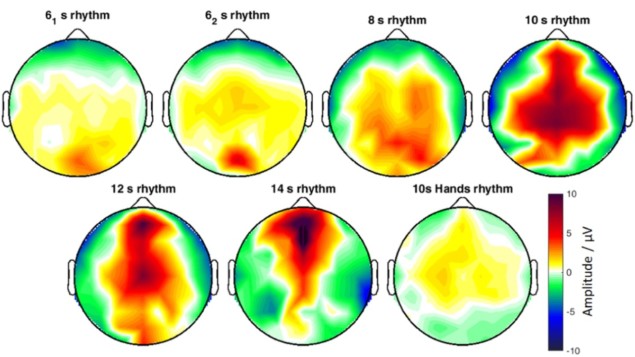
Regulation of breathing, for example using pranayama breathing techniques applied in yoga and meditation, is associated with various health benefits. German researchers have investigated the link between body rhythms and slow cortical brain dynamics during paced breathing and found a prominent synchronous influence of a 10 s breathing rhythm on heart rate variability. The study revealed the relationship between breathing rhythm, heart rate and slow cortical potentials (SCP) of the brain, and supports future research into the effect of breathing on mental health (J. Breath Res. 10.1088/1752-7163/ab20b2).
The research team, from the Universitätsklinikum Regensburg, examined the effects of SCPs – slow shifts in cortical electrical activity at frequencies below 1 Hz – as influenced by five different breathing rhythms. Prior research has demonstrated that SCPs are strongly task-related, with positive SCPs leading to decreased cortical excitation and negative SCPs supporting neuronal activation.
“Demonstrating the relationship between SCPs and breathing rhythms in detail is of the highest interest, as the self-regulation of SCPs is targeted in neurofeedback approaches and used to control brain–computer interfaces,” the authors explain.
Principal investigator Thilo Hinterberger and colleagues in the Department of Psychosomatic Medicine enrolled 37 volunteers, 14 of whom were experienced in meditation, to participate in paced breathing sessions.
The breathing session included 5 min of breathing normally in a comfortable sitting position. After this baseline data collection, the individuals performed six, 7 min long, task sequences with 6, 8, 10, 12, 14 and 6 s breathing cycles. Instructions for inhalations and exhalations that mimicked natural breathing patterns were illustrated visually on a monitor.
Participants were asked to subjectively rate each breathing rhythm with regards to its naturalness, “goodness” of feeling and arousal during a 3 min long period of relaxation between each recorded breathing cycle.
Upon completion of the final 6 s breathing task, included to account for a possible sequence effect of the task, participants were asked to breathe normally while opening and closing their right hands in a 10 s rhythm. The authors explained that this was done to control the influence of general task execution on the brain response.
The researchers measured heart rate variability and SCP data from a 64-channel electroencephalogram (EEG), as well as respiratory signals recorded from a belt surrounding the chest. Breathing-related heart rate variability and event-rate SCP were calculated by averaging all breathing cycles of all participants separately for each breathing rhythm.
Both heart rate variability and SCP spectrograms showed that each paced breathing task elicited a sharp frequency response at the corresponding breathing frequency. While breathing depth increased only slightly in slower breathing rates, heart rate variability and SCP curves showed strong increases at slower breathing rates.
The highest resonant peak in amplitude as measured by both heart rate variability and the SCPs of the brain occurred at the 10 s breathing rhythm (six breaths per minute), the major novel finding of the study, according to the authors.
“The finding that there is a high maximum resonance in SCPs when breathing with six cycles per minute indicates that this decelerated breathing rhythm induces a strong resonance of SCP, heart rate variability and the metabolic baroreflex, the fastest mechanism to regulate acute blood pressure changes,” Hinterberger told Physics World. “Subjectively, decelerated breathing is reported to have a relaxing and positive effect.”
“One question for future research is how this SCP resonance interacts with brain processes that control feelings of wellbeing,” he added. “We assume that the electrocortical SCPs might be connected to metabolic changes. However, there might be several subcortical structures involved which are related to emotional states of consciousness. This will be a subject of future research.”



